
Last week Rob wondered if you follow carefully laid-out plans or just design your projects as you build them. – Editor
“I’m a lot like you: I think it up, know what it should look like and then just start making sawdust. I have never bought a set of plans.” – Lowell Taylor
“Most of the time, I build straight from my mind. About the only thing I do is figure out what amount of material I need to get. I do build from plans also, but usually I see it in my mind and build it.” – Rudy Gonzalez
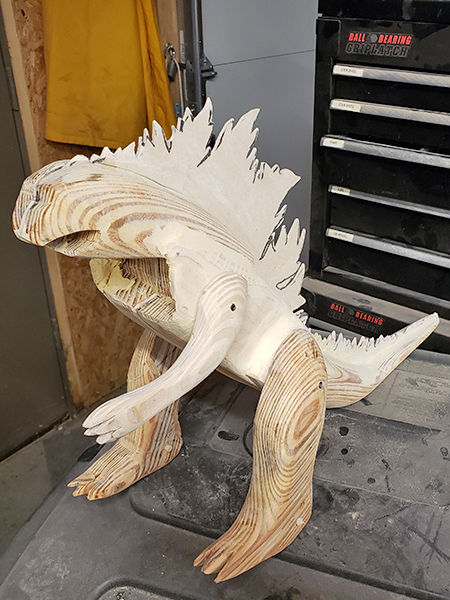
“I have been woodworking since I was very young (I’m now now 74 years old). Every room of our house has at least one item of furniture that I built. I have “made a lot of sawdust” over the years. I’m also a retired architect and therefore tend to make fairly detailed design drawings of my projects before starting on them. This is easier for me, but may not be for many others. We have one grandson, now seven years old, and I have made several toys for him. The latest was a Godzilla toy that ended up being more of a sculpture than a typical woodworking project. It is 14 in. tall, 28 in. long and 8 in. wide. It was based on his concept of a toy Godzilla robot that could be “operated” by two toy people located in a hinged compartment in its neck. It has a wheel recessed in each leg and a furniture glide below its tail so it will move without scratching their hardwood floors. The arms also swivel up to near his mouth. There are two storage compartments in his back for hauling other small toys. All three compartments have hinged doors. The main part of the body and legs are made from an old yellow pine 2×10 I had lying around (very bad choice … hard to work with and brittle) and Baltic birch plywood. There are a total of 25 different pieces of wood in the final project. Of course, Godzilla was not made of wood, so he wanted it painted. Our grandson lives over a hundred miles away, so he couldn’t help me build it, but I treated him like a client on a construction project and we had a series of video conference calls to discuss design drawings and how to resolve constructability issues. This allowed us to stay in touch this past spring while we were all under ‘stay at home’ orders due to COVID-19 concerns. He is pleased with the result, so I am calling it a success.” – Jim Hunt
“I’m in the process of building a mirrored bathroom vanity for our guest bath from ‘plans’ … my wife has requested a youth’s desk for our 12-year-old that will HAVE to be from envisioning what will work for our needs (fit under a loft bed) and be mobile to roll into the family room for homework/computer time. My daughter’s loft bed was built from plans; my wife’s desk was ‘created’ from an entertainment armoire which was too small for our newish flat screen TV that sits on a repurposed dresser. So, YES! I create both from plans AND from conception/envisionment. Thanks for the continued encouragement and stretching of skills!” – Joseph Gill III
“I guess I’m a 50/50 kinda guy when it comes to this subject. I have, for the past few years, been a student at a community college that has an outstanding woodworking program. Each class I’ve taken that is project-based (as opposed to a skills class like hand tools) has required the submission of a set of plans. So those projects I’ve built within the confines of the curriculum have all been from plans. Projects that I’ve built at home have also come from plans, but they were of my own design. Typically I will choose a project and then research via the Internet, magazines, etc., how others have built the same or a similar project. I will then draw up a set of plans for what I want to build. I have built a number of items of shop furniture/stands for equipment that had no plans attached. I will measure the footprint of the item of machinery, then build a cabinet with drawer(s) on which to place it. Currently, I’m working on a major build and two minor projects (a dovetailed box to hold my sharpening stones and new doors for a garage cabinet that will become tool holders for hand tools and layout equipment).” – Ralph Lombardo
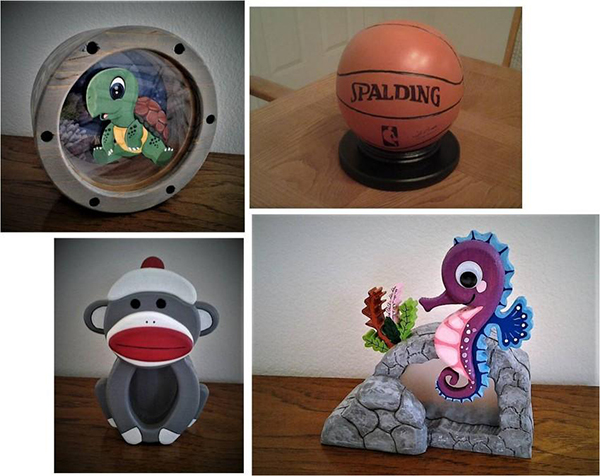
“I get requests all the time for coin banks like these (above) with different children’s themes. I tend to just go out to the shop, sketch something out and start cutting. I find that the challenge and creativity is in defining the process. The process for a basketball bank is totally different from a sock monkey bank or a seahorse bank.” – Michael Riffel
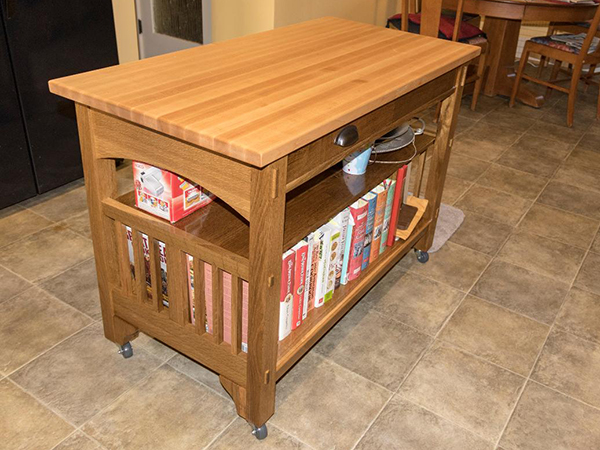
“I rely on plans, but I never see other plans that meet my need. Still, I do agree with you that there are two kinds of woodworkers (well, at least two): those who have an idea, go into the shop, and come out with a beautiful table, highboy, whatever. Then there are those who must have a plan with all joinery, dimensions, etc., marked out before they enter the shop. I am of the latter category. For over 40 years I was a scientific glassblower. I made the kinds of things you see in movies or documentaries with coiled tubing and things with boiling liquids churning away. I made most of my work for California State University, Los Angeles. I am retired now. When one of the very first Macs were sold, one of the professors brought his into the department to show everyone, and I was fixated. I played with the vector program that came with the Mac (MacDraw) and instantly realized that I could draw glass apparatus and get the design measurements down before I ran into issues. (Napkin drawings run rampant in universities, and folks like me are expected to make them real.) Soon I realized the deficiencies of MacDraw and learned about an actual CAD program MacDraft (this is in 1985). I’ve been using MacDraft ever since and, while I no longer make glass apparatus, I do all of my woodworking designs (like the kitchen island above) in MacDraft before building the projects. I also use it to make design decisions; I know what I want to end up with but need to settle on how it will look. Because of this I’ll do a basic drawing with the dimensions that I want and then work with the design features that will satisfy my visual needs and wants. Trust me, I hail those who do not need to do this … I wish I had their capability. Fortunately though, we are both right.” – Gary Coyne
“I’ve built a few things from plans, but I really enjoy just getting an idea, sketching it out and then going for it. Sure, it may not end up exactly the same as planned, but then that is the fun: seeing what you can do along the way and making it work. It’s woodworking not bridge-building, and unless it has to be an exact size to fit a specific area, why not just have some fun.” – Frank McEnulty
“I actually hate working from plans from someone else’s mind. The project I design and build is really more fun. To make something from someone’s plans is a totally different project — to me, it amounts to working to get it right, which is hard work. On the other hand, making something from my own creativity is fun.” – Phil Zoeller
“This probably is my most often-repeated moment of dread — or just the wish that I could lay my hands on a nice clean set of plans. The design isn’t what stops me in my tracks but the dimensioning and fit and the flow of design that can run off the tracks at this juncture. I am speaking of ‘one-of-a-kind furniture’ where this is the usual issue for me. It has not been problematic for me with other types of projects. I have built houses, small commercial office buildings, done a variety of turning for many years and so on. I go through more agony building a dresser, desk, chairs, tables that I wonder at my sanity … Who would let themselves into this much torture? People brag and praise my efforts, but I am not happy with the results when I know how many mistakes I have had to fix. So, yes this is an interesting problem, and my answer is simply build two or three of everything to get through all those mistakes. That doesn’t seem reasonable for ‘oak’ projects, but it would get me out of this conundrum.” – Greg Thacker
“I prefer to design and build my projects. Though my priority is functionality, I try to make them blend with their surroundings. I really enjoy developing an idea and figuring out how to do it. After that, actually building it is the easy part.” – Henry J. The
“I have always preferred to built projects from my own designs. Otherwise, it’s just building ‘cookbook’ style. There is reward in the finished item, but the real mind-blower is taking an idea, planning all the details on paper, applying the plan to some formless wood and turning it into something of utility and beauty. Creativity is truly what prompts the mind to grow in scope and expand in perception.” – Dwight Davis
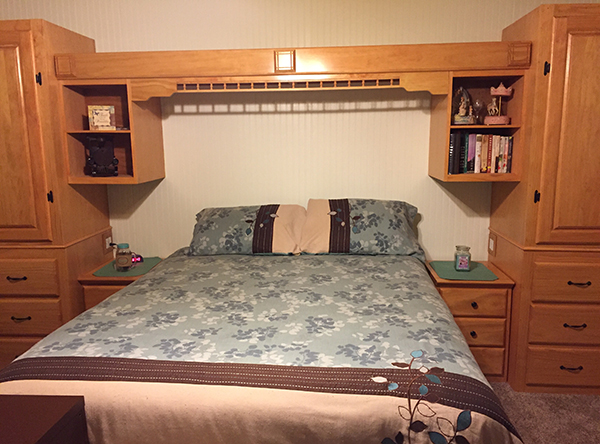
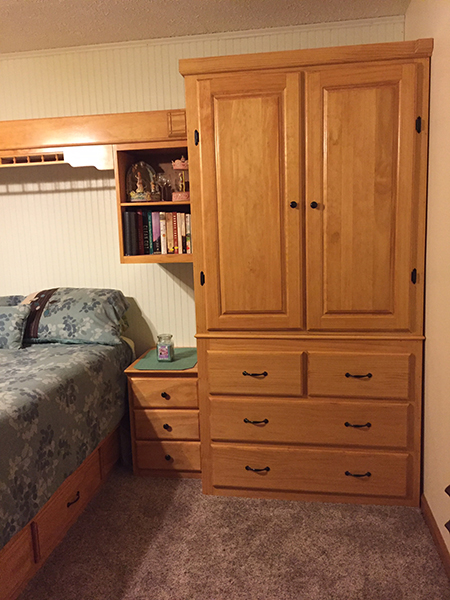
“I liked your article about designing in your head and building without plans. When my wife wanted a new bedroom set (shown above), I went to my shop with nothing but a picture in my head and the wall-to-wall dimensions. In addition to making a lot of sawdust, I also put in dimmable LED lights under the bookcases and one over each side in the overhead valance. She loves the results. Happy wife, happy life.” – Tommy Thomason
“At my current level of experience, plans are a huge help even if I wind up diverging from them. I don’t yet have enough of a sense of structure to want to attempt anything much larger than a shoebox without seeing a couple of examples of how others approached it. Learning from mistakes us great; learning how to avoid mistakes is even more so. ‘Anyone can build a bridge that will stand. It takes an expert to build one that is just strong enough to stand up to specific requirements while minimizing cost.’ The same is true of most forms of design and engineering.” – Keshlam Cat
“I usually start with a pretty good idea of what the final project should look like, but for the most part the design and construction are happening simultaneously. Working from plans certainly has its place, but unless you add you own flourish to them, you are, in the end, building someone else’s design. If I use plans, they are only a guideline of the basic project; scale and dimensions can all be altered to fit my needs.” – Edward Weber





